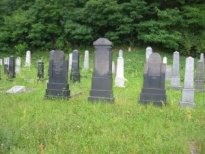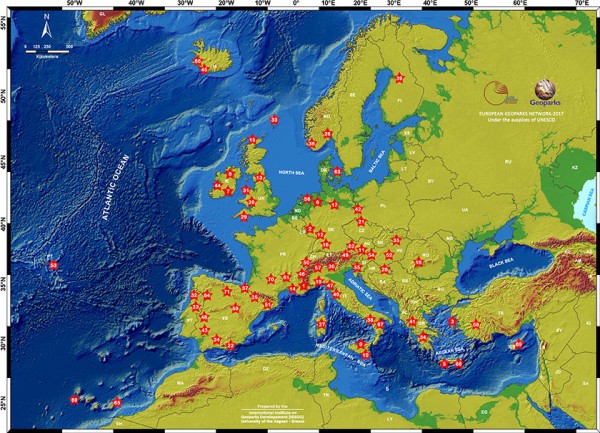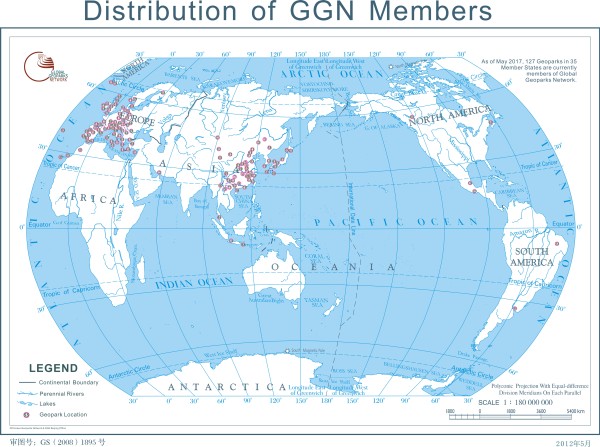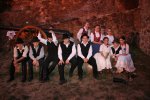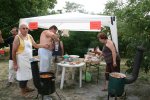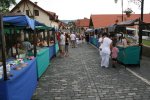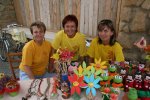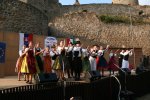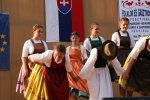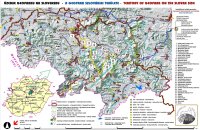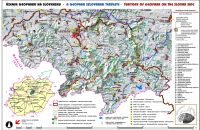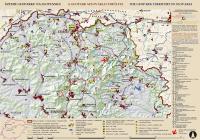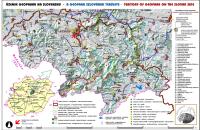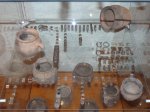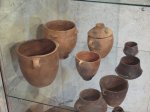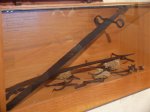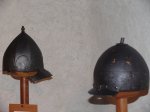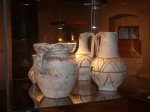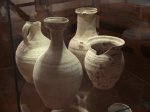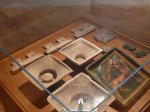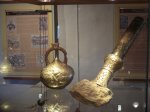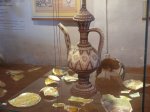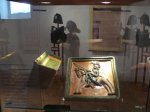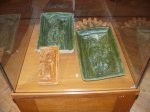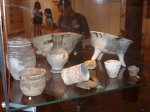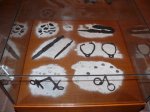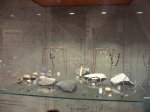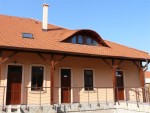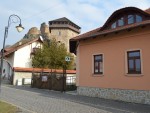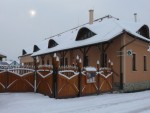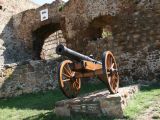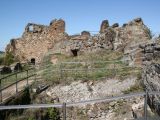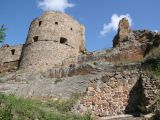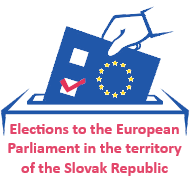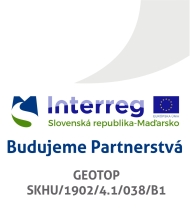
Contacts
Fiľakovo Town Hall
Radničná 25, 986 01 Fiľakovo
Tel.: +421-(0)47-4381001
Email: mesto@filakovo.sk
Office Hours
Monday - Thursday:
7:30 - 11:30 a.m. /
12:30 - 4:00 p.m.
Friday: 7:30 - 11:30 a.m.
Elections to the European Parliament in the territory of the Slovak Republic
Information for the voter [PDF, 25 kB]
Catering, accommodation, taxi services
Catering, accommodation, taxi services - www.hradfilakovo.sk
Event calendar
Event calendar [PDF, 4,94 MB]
Accessibility declaration
The web site complies with standards of the Decree of Ministry of Finance No. 312/2010 Coll. on Standards for Public Administration Information Systems.
Content of website is generated with open source content management system CMS Joomla!.
About Fiľakovo
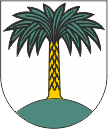 The slovakian centre of the cross-border Novohrad-Nógrád Geopark is Fiľakovo town. The first written records about the town date from the first half of the 13th century. As early as that there was a settlement under protection of the strong castle. It received township rights and the settlement became Fylek Town in 1423. After the cruelty of the Tartars and the flagrant robbery of knight Fulcus, the Turks, who had been in Fiľakovo and it's environs for 39 years, captured the castle in 1554. During this period Fiľakovo was the Ottoman Empire's only Sanjak (county) seat in Slovakia's current territory. The golden age of the town was the 17th century when it was ruled by impressive personalities, such as Tamás Bosnyák, Ferenc Wesselényi, and István Koháry II. The destiny of the castle and town was sealed at the end of the 17th century when the castle was captured and reduced to ruins by Imre Thököly.
The slovakian centre of the cross-border Novohrad-Nógrád Geopark is Fiľakovo town. The first written records about the town date from the first half of the 13th century. As early as that there was a settlement under protection of the strong castle. It received township rights and the settlement became Fylek Town in 1423. After the cruelty of the Tartars and the flagrant robbery of knight Fulcus, the Turks, who had been in Fiľakovo and it's environs for 39 years, captured the castle in 1554. During this period Fiľakovo was the Ottoman Empire's only Sanjak (county) seat in Slovakia's current territory. The golden age of the town was the 17th century when it was ruled by impressive personalities, such as Tamás Bosnyák, Ferenc Wesselényi, and István Koháry II. The destiny of the castle and town was sealed at the end of the 17th century when the castle was captured and reduced to ruins by Imre Thököly.
Fiľakovo Castle Museum situated in an impressive renaissance tower, named after Ferenc Bebek, welcomes visitors since August 2008; it introduces the history of the town and castle from the first written reference to the destruction of the castle. In historical town centre is located the Church Devoted to Holy Mary´s Assumption and the Franciscan Monastery National Cultural Monument. Attention of visitors also deserves some historical buildings, such as: Town Hall, Redout, Berchtold Manor-House, Cebrian Manor-House, and the Koháry Mansion. Town Museum welcomes visitors with temporary exhibitions of local history, folk culture and art. The upcoming exhibition will be devoted to history of Fiľakovo after destruction of the castle, with special accent on history of local enamel industry. Novohrad Tourist Information Center provides information about attractive sights, cultural events in the town, and hiking opportunities in it´s surroundings.
Content administrator and Technical operator
Content administrator
Mesto Fiľakovo
Radničná 25
986 01 Fiľakovo
Slovak Republic
Tel./fax: +421-(0)47-43-81001
Email: This email address is being protected from spambots. You need JavaScript enabled to view it.
Org. Reg. No.: 00316075
Technical operator (Hosting service provider)
WebHouse, s.r.o.
Paulínska 20
917 01 Trnava
Slovak Republic
Tel.: +421(0)33-29-33-500
Fax: +421(0)33-29-33-543
Org. Reg. No.: 36743852
www.domains.sk
Twin towns
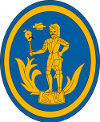 Szécsény
Szécsény
Szécsény lies in Hungary, in the Northern part of Nógrád county, on the Slovakian border, in the valley of the river Ipoly. Two other settlements belong to Szécsény administratively: Pösténypuszta, located right on the bank of the river Ipoly and Benczúrfalva, found 4 km from the town. The population is not much over 6.000. Archeological findings attest that the Ipoly valley and its broadening Szécsény basin have been inhabited since the Neolithic age. The first written document about the town dates back to 1229. Szécsény’s flourishing fell in the first half of the 14th century, when it took on an agricultural character, and became the centre of the surrounding settlements. In 1332 Chief Justice Tamás Szécsényi got permission from Pope John XXII to establish a Franciscan monastery. King Charles Robert gave Szécsény the order of the market town in a diploma of 5 May 1334. Thereafter the building of the church and the monastery was completed and the fortified castle was also built. In 1552 the settlement passed under Turkish rule. After more unsuccessful attempts the town, which was also important because of the Upper Hungarian mining towns, was reoccupied in 1593. In 1663 Szécsény came under the rule of the Turkish again, then in 1683 the Polish king Jan Sobieski’s troops - on their way back from Vienna - liberated the town once and for all. Later a plague broke out and the town became almost uninhabited. The resettlement was initiated by the Franciscans who sent, among others, János Bárkányi, Ferenc Rákóczi II’s tutor into the town. In 1705 Ferenc Rákóczi II, changing the original plan, convened the Diet into Szécsény, where he was elected the Prince of Transylvania and commander-in chief of the Hungarian insurgent forces. At the end of the 18th century the town was ravaged by a fire. After the fall of the 1848/49 Revolution and War of Independence Szécsény was occupied by imperial troops. Szécsény was deprived of its town status in 1886. The pace of development did not increase significantly after the turn of the century and it was also hindered by the Trianon Peace Treaty, the Second World War and the 1956 revolution. Development began in the 1960s, in consequence of which Szécsény got back its town status in the January of 1986. From this time on, Szécsény has lived its everyday life as a town and as the most significant educational, cultural and touristic centre of the area. In the past decade Szécsény came to life again. The historical centre of the town has got a new look thanks to EU resources: public institutions such as the kindergarten, the school, the community centre, the library, the mayor’s office and the health centre have been renovated. With EU resources these institutions can also be reformed in content.
Contacts:
Town Hall - Szécsény Városi Polgármesteri Hivatal, 3170 Szécsény, Rákóczi út 84.
Tel.: +36-32-370-199; +36-32-370-237, fax: +36-32-370-170,
email: This email address is being protected from spambots. You need JavaScript enabled to view it., www.szecseny.hu
Salgótarján
Bátonyterenye
The Novohrad-Nógrád Geopark - Ancient world without borders
What is a Geopark?
According to UNESCO Geopark is defined as a protected national area with a number of geological heritages, which contains particularly important rarities and have aesthetic attraction. These Earth heritage sites involves protection, education, and unified concept of sustainable development.
European Geopark Network
The European Geoparks Network (EGN) was established in 2000. It aims are to protect geodiversity, to promote geological heritage to the general public as well as to support sustainable economic development of geopark territories primarily through the development of geological tourism. The network has drawn together territories from across 58 European zones that share these aims and which are now working together in an active and dynamic way to achieve them (september 2013).
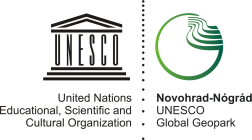

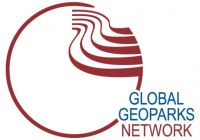
The Global Geoparks Network is supported by United Nations Educational, Scientific and Cultural Organization (UNESCO). The Global Geoparks Network works in synergy with UNESCO's World Heritage Centre and Man and the Biosphere (MAB) World Network of Biosphere Reserves.
Novohrad-Nógrád Geopark
Novohrad-Nógrád Geopark is the first geopark in the European Geoparks Network and Global Geoparks Network assisted by UNESCO that has been an international (cross-border) geopark from 27th March 2010, when as 36. member in Luberon (France) joined to the European Geoparks Network. There are sereval sites of earth-scientific importance which also provide a spectacular sight. The organization is charge of the geopark management preserves and presents geological, landscape, natural, ecological, archaeological, historical and cultural heritage and integrates all these to form geo/touristic offers, thereby developing the local economy. It converges 28 slovakian and 63 hungarian settlements.
The member municipilaties of Geopark (PDF, 481 kB)
List of partners (PDF, 384 kB)
Local experts
- Andrea Mágyelová, accounting
- Ing. arch. Erika Anderková, architect, project management
- Ing. Peter György, construction, regional government
- JUDr. Norbert Gecso, law and legislation
- Mgr. Attila Agócs, history
- Jozef Klinda
- Ľudovít Gaál
Businessmen and tradesmen
- FOTO-GRAFIK, Schnelczer Zoltán
- Ing. Molnár Alexander, interpreter, translator
- MANUfakt, Štefan Gyetvai, craft works
- Presston polygrafická výroba, Bc. Peter Baláž, printing of promotional materials
- Schneider Róbert, packaging
- TURUL EUROLINE s.r.o., Szakó Ladislav, transport service
Leaflets
- Krajinou najmladších sopiek (SK-HU-EN)
- Mapa vybraných geologických lokalít, Novohrad-Nógrád geopark územie SR (SK-HU-EN)
- Novohrad-Nógrád Geopark, Po stopách dávnej minulosti (HU-SK-EN)
- Pešia turistická trasa 1, na území Novohrad-Nógrád geoparku, Náučný chodník Šomoška (SK, HU)
- Pešia turistická trasa 2, na území Novohrad-Nógrád geoparku, Šomoška-Medveš-Boszorkánykő-Šomoška (SK, HU)
- Geopark Novohrad-Nógrád sa predstaví (SK, HU,EN)
Studies
- Metodická príručka + Pracovný zošit 2010 (SK, HU)
- Hodnoty Novohrad-Nógrádu 2010 (SK, HU)
- Náučná lokalita Veľký Hargič, štúdia uskutočniteňosti 2012 (SK)
- Program starostlivosti o územie geoparku (SK)
- Geologické hodnoty územia geoparku (SK)
- Význam Geoparku z archeologického, kultúrno-historického hľadiska (SK)
- Parciálne analýzy pre projekt Novohrad-Nógrád geopark (SK)
- Cyklotrasy Novohrad-Nógrád geoparku, štúdia uskutočniteľnosti, 2012 (SK)
- Vyhodnotenie potenciálu územia (SK)
- Vulkanologický a mineralogicko-petrologický súhrn poznatkov o území navrhovaného Novohradského geoparku, 2007 (SK)
- Riadiaca a výkonná štruktúra geoparku (SK)
- Stratégia trvaloudržateľného rozvoja územia (SK)
- Význam geoparku z hľadiska ochrany prírody a krajiny (SK)
- Príloha a formulár žiadosti o grant (Phare) (SK)
- Príručka oprávnených výdavkov, vydaná v rámci programu cezhraničnej spolupráce MR-SR 2007-2013 (SK, HU)
- Kontrolný systém v SR (SK)
- Príručka pre žiadateľov vydaná v rámci programu cezhraničnej spolupráce MR-SR 2007-2013 (SK, HU)
- Control is Hungary-Validation of expenditures (EN)
- Visibility guide for projects 2009 (EN)
- Príručka pre prijímateľa vydaná v rámci programu cezhraničnej spolupráce MR-SR 2007-2013 (SK, HU)
- Spoločná záchrana a prezentácia kultúrneho a prírodného dedičstva na území ERN 2006 (SK)
- Gazdaság- és vállalkozásfejlesztő szervezet üzleti terve Fülek város és Obrucná mikrotérség fejlesztésére (HU)
- Obnova ekosystémov, učebné texty (SK)
- Stratégia rozvoja geoturizmu (SK)
- Helyi értékek kutatása, ismertetése és védelme, Diákok munkáinak és tevékenységének bemutatása (HU)
- Researcher and Experience Camp (EN)
- Putovanie krajinou najmladších sopiek (SK)
- Putovanie s Geou (SK)
- Archeologické, historické a kultúrne hodnoty na území budúceho Geoparku (SK)
- Geologická stavba a charakteristika útvarov maďarskej časti Nógrádsko-Novohradského Geoparku (Géza Császár, 2007) (SK)
- Novohrad-Nógrád Geopark (SK)
- Novohradský Geopark, Súhrnné štúdium miestneho obyvateľstva a o kooperačných možnostiach (SK)
- Novohradský Geopark, Stručný prehľad aktuálnej primárnej a sekundárnej ponuky CR (SK)
- Strategické akčné plány rozvoja vidieka BBSK, Strategický akčný plán vidieckeho regiónu Novohrad skrátené znenie (SK)
- Analýza sociálneho, hospodárskeho a infraštrukturálneho stavu Novohradského geoparku (SK)
- Analýza rizík Novohrad-Nógrád Geoparku (maďarská časť) (HU)
- Nógrád-Novohrad Geopark, hodnoty živej prírody a ochranársky významné územia: chránené územia, navrhované chránené územia a ich ohrozenosť očakávania a návrhy na ich ochranárske využitie (SK)
- Projekt Novohradský Geopark (SK)
- A Nógrádi Geopark társadalmi, gazdasági, infrastruktúrális helyzetének elemzése (HU)
- Utazás a Föld belsejébe, tudományos ismeretterjesztő oktatási segédanyag (Dr. Harangi Szabolcs) (HU)
- Menjünk kirándulni Béri „andezitcsúszda”, tudományos ismeretterjesztő oktatási segédanyag (Dr. Harangi Szabolcs) (HU)
- Analýza súčasného stavu a návrhy na vybudovanie lokalít (Spätná erózia, Andezitový kameňolom, PP Belinské skaly) (SK)
- Náučný chodník: Spätná erózia, Andezitový kameňolom, PP Belinské skaly (SK)
- Projektová dokumentácia stavby Spätná erózia (SK)
- Projektová dokumentácia stavby Andezitový kameňolom (SK)
- Projektová dokumentácia stavby PP Belinské skaly (SK)
Highlighted Events
Palóc Easter
It will be held on Easter Monday in the castle. Visitors will be showed some handicrafts and workshops. There will be performances for children, performances of local folk dancers and archers. Traditional cakes such as gingerbread will be sold.
The Night of Museums
The Castle museum in Fiľakovo is the participant of this cultural event organized by multiple museums and cultural institutions in Europe. Fiľakovo takes part in the event from 2008. It is held on Saturday before the 18th May when is the International Day of Museums. The exhibition is free of charge.
The International Novohrad Folk Festival
It is usually held the last weekend in July. It connects the culture and traditions of two nations - the Hungarians and the Slovaks. It presents the traditions of Novohrad region. There are performances of both local and foreign folk dancers. The final programme is the house of dance in the castle.
The Fiľakovo Historical Castle Games
The event will be held the last weekend in June in the castle. The programme will include an archery competition. The winner gains the tittle of "The Archer of Novohrad" and the rank of "The Defender of the castle". There will be showed some folk and historical handicrafts, programmes for children, performances of historical fencing, falconers, jugglers and a cannonade.
The Palóc Days
It is a three day feast in Fiľakovo. It includes performances of both local and foreign theatricals, programmes for children, concerts of different groups and artists.
Photo: Zoltán Schnelczer, Town of Fiľakovo
Hiking Trails
Hiking trail: Fiľakovo (railway station) -› Belina -› Malobelinská hora -› Saddle bellow Monica -› Šurice, Nature reserve Soví hrad -› Hajnáčka (railway station)
- Degree of difficulty: moderately difficult
- Length of trail: approx. 19 km (11.9 miles)
- Time: approx. 4 h 45 min.
- Elevation gain: 288 m (945 feet)
Trail marks:
- yellow markers - mark short connecting trails to other trails that are marked with different colors
- trail number: 8460
Trail map:
Level of protection:
- Nature Monument Soví Castle: level 5
Can be visited on the marked trails. Please adhere to the rules for the level of preservation that is marked. - Nature Monument Belina Rocks: level 5
Can be visited on the marked trails. Please adhere to the rules for the level of preservation that is marked.
Services:
- Belina - pub
- Šurice - pub
Connections: Hajnáčka - Fiľakovo
Photogallery
Plants and animals
Hiking trail: Fiľakovo -› Hajnáčka (railway station) -› Nature Conservation Area Pohanský hrad -› Saddle Garád -› Saddle below Monica -› Obručná -› Mačacia Quarry -› Šiatorská Bukovinka
- Degree of difficulty: moderately difficult
- Length of trail: approx. 20 km (12.5 miles)
- Time: approx. 4 h 35 min
- Elevation gain: 343 m (1125 feet)
Trail marks:
- green markers (trail number: 5486) - marks access roads leading to interesting touristic destinations
- red touristic marks (trail number: 0813) - the most important ridge trails
Trail map:
Level of preservation:
- Nature Conservation Area Pohanský Castle: level 5
Can be visited on the marked trails. Please adhere to the rules for the level of preservation that is marked. - Mačacia Quarry: level 2
Please adhere to rules for the level of preservation that is marked.
Services:
- Obručná - accomodation, meals
- Šiatorská Bukovinka - restaurant
- gas station on the border (SK)
Other attractions:
- Entrance to NCH Šomoška: playground with wooden swings, small football field, fire pit, snack, postcards, souvenirs, etc.
The tower is open from April 1st till October 31st. The nature trail is open year round. - Entrance fee for the nature trail - including NCH Šomoška Castle: adults 1.15 €, children and students 0.50 €. Parking fee for cars: 1.15 €, buses 2.30 €
- Reservoir Šiatorská Bukovinka with the possibility to fish (with a valid licence).
Connections:
Fiľakovo - Hajnáčka žel. stanica
Šiatorská Bukovinka - Fiľakovo
Photogallery
Hiking trail: Fiľakovo -› Šiatorská Bukovinka -› Mačacia Quarry -› Šomoška Nature Conservation Area -› Šiatorská Bukovinka
- Degree of difficulty: easy
- Length of trail: approx. 10 km (6.3 miles)
- Time: approx. 2 h 30 min
- Elevation gain: 230 m (1050 feet)
Trail markers:
- yellow markers - mark short connecting trails to other trails that are marked with different colors
- green markers (trail number: 5467) - marks access roads leading to interesting touristic destinations
- educational trail - touristic and excursion trails marked in various ways and with varying length and theme, nature trails, countryside trails - denote culturally or historically interesting or typical regions
Trail map:
Level of protection:
- Mačacia Quarry: level 2
Please adhere to the rules for the level of preservation that is marked. - Šomoška Castle National Cultural Heritage (NCH): level 5
Can only be visited on the marked trail. Please adhere to the rules for the level of preservation that is marked.
Services:
- Šiatorská Bukovinka - restaurant, pub
- gas station on the border (Slovakia)
Other attractions:
- Entrance to NCH Šomoška: playground with wooden swings, small football field, fire pit, snack, postcards, souvenirs, etc.
The tower is open from April 1st till October 31st. The nature trail is open year round. - Entrance fee for the nature trail - including NCH Šomoška Castle: adults 1.15 €, children and students 0.50 €. Parking fee for cars: 1.15 €, buses 2.30 €
- Reservoir Šiatorská Bukovinka with the possibility to fish (with a valid licence).
Connections:
Fiľakovo - Šiatorská Bukovinka
Šiatorská Bukovinka - Fiľakovo
Photogallery
Hiking trail:
Section I: Fiľakovo -› Šiatorská Bukovinka -› National Cultural Heritage Šomoška Castle
Section II: National Cultural Heritage (NCH) Šomoška Castle (parking on the Hungarian side) -› Medves Plateau -› Salgóbánya village -› Salgó Castle -› Basalt crest Boszorkánykő -› Salgótarján, part Eresztvény -› Salgótarján, part Somoskő -› Somoskőújfalu (railway station) -› Šiatorská Bukovinka (bus stop by the border)
- Degree of difficulty: moderately difficult
- Length of the 1st section of the trail: 3.8km (2.4 miles) - if you arrive by bus, 5 km (3.1 miles) if you arrive by train
- Length of the 2nd section of the trail: 11.35 km (7.1 miles) return by train from Somoskőújfalu, 16.2 km (10.1 miles) return by bus from Šiatorska Bukovinka
- Duration of 1st section: approx. 1 hour - if you arrive by bus, approx. 1 hour 20 min - if you arrive by train
- Duration of 2nd section: approx. 3 hours - return by train from Somoskőújfalu, approx. 4 hours - return by bus from Šiatorska Bukovinka
- Elevation gain: 320 m (1050 feet)
Trail markers:
- on the Slovak side: green markers - number of trail 5467
- on the Hungarian side: red markers, yellow markers
Trail map:
Level of protection:
- Nature Conservation Area Šomoška: level 5
Can be visited on the marked trails. Adhere to nature protection according to the level of protection.
Services:
- Šiatorská Bukovinka (SK) - meals
- gas station on the border (SK)
- Somoskő (HU) - accomodation, meals
- Somoskőújfalu (HU) - accomodation, meals
- Salgóbánya (HU) - accomodation, meals
Other scenic spots:
- At the entrance of Nature Conservation Area Šomoška: playground with wooden swings, small football field, refreshments, fire pit, postcards, souvenirs, etc.
The tower is open from April 1st to October 31st. The education trail is open year round. - Entrance fee to the nature trail includes entrance to Šomoška castle. Adults: 1.15 EUR, children and students: 0.50 EUR. Parking fee: cars 1.15 EUR, buses: 2.30 EUR
- Šiatorská Bukovinka reservoir with the possibility of fishing (with a valid licence).
- Small zoo in Šiatorská Bukovinka, hoofed animals (deer, wild boar, fallow deer, wild sheep)
Summer hours: Tuesday-Sunday (2pm-6pm). Also open during winter Saturday-Sunday: 10am-2pm. Entrance fee: 300 HUF. Contact tel. 00-36-32-430940 - Ranger's house in Salgóbánya
Summer hours: Tuesday-Sunday (9am-3pm). Winter hours: Saturday-Sunday (10am - 2 pm). Entrance fee: 300 HUF
Contact tel. 00-36-32-435049
Note: Groups can visit the ranger's house or the small zoo besides the hours mentioned above. - Ferenc Zenthe Memorial Park
- Bird Park (free entrance)
Connections:
Fiľakovo - Šiatorská Bukovinka
Šiatorská Bukovinka - Fiľakovo
Photogallery
Hiking trail: Fiľakovo -› Šiatorská Bukovinka -› Mačacia Quarry
- Degree of difficulty: easy
- Length of trail: 5,1 km (3.2 miles)
- Time: 1 hour 20 min.
- Elevation gain: 185 m (607 feet)
Trail markers:
- yellow markers (trail number: 8467) - mark short connecting trails to other trails of different colors
- red markers (trail number 0813) - the most important ridge trails
- green markers (trail number: 5467) - mark access roads leading to touristic destinations
- educational trail - touristic and excursion trails marked in various ways and with varying length and theme; nature trails, countryside trails - denote culturally or historically interesting or typical regions.
After visiting Mačacia Quarry, you can continue on the green trail to Šomoška Castle National Cultural Heritage.
Trail map:
Level of preservation:
- Mačacia Quarry: level 2
Please adhere to the rules for the level of preservation. - Šomoška Castle National Cultural Heritage: level 5
Can only be visited on the marked trail. Please adhere to the rules for the level of preservation.
Services:
- Šiatorská Bukovinka - restaurant, pub
- gas station on the border (Slovakia)
Other attractions:
- Entrance to Nature Conservation Area Šomoška: playground with wooden swings, small football field, fire pit, snack, postcards, souvenirs, etc.
The tower is open from April 1st till October 31st. The nature trail is open year round.
Entrance fee for the nature trail - including NCH Šomoška Castle: adults 1.15 €, children and students 0.5 €. Parking fee for cars: 1.15 €, buses: 2.30 € - Reservoir Šiatorská Bukovinka with the opportunity to fish (with valid permit).
Connections:
Fiľakovo - Šiatorská Bukovinka
Šiatorská Bukovinka - Fiľakovo
Photogallery
Trails of folklore
This section of the webpage was created within the implementation of the project called "Palóc Journeys - the complex development of a visitor oriented thematic route" - HUSK 0801/1.3.1/0071.
This announcement reflects the opinion of the author and the Governing Authority is not responsible for the possible usage of the presented information. The content of this webpage does not necessarily represent the official position of the European Union.



Kalonda - Studená - Fiľakovo - Radzovce
Kalonda
Located 8 km south of the town of Lučenec. It was first mentioned in the geographical dictionary compiled by Elek Fényes. Homestead of the Kalondai and Széchenyi families till 1554. During the 14th - 16th centuries it split into two villages, which united again after the Turkish invasion. More information: www.kalonda.eu
Places to visit
- Palóc Museum
- Roman Catholic Church consecrated to prince Saint Imre (the 500 year old red marble tombstone of György Kalonday - founder of Kalonda - was placed into the wall of the church)
Palóc Museum
The exhibition in the village-house, which is over 100 years old, shows village life through an authentic kitchen and what was known as the palóc 'clean room' (known throughout the palóc region - the clean room was furnished with the best furniture, decorative plates on the walls, a cross, pictures of saints, a corner bench and a bed with beautiful linens. This room was only used on special occasions.) The exhibits were donated to the museum by villagers. The remaining portion of the exhibit introduces us to the history of the village and the region from the time of the Hungarian/Magyar conquest to nowadays.
Open: every day by appointment by calling Sandor Papp, Pro Kalondiensis Civic Association on tel. number: 00-421-(0)903-534153 Entrance fee: donation
Parking: in front of the museum or in front of the building of the local government.
Studená
Located 22 km souteast of Fiľakovo along the Hungarian border. The village was established after the Tatar invasion in the boundaries of Nová Bašta. The first part of its Hungarian name originates from Medvespuszta, located near the village of Somoskő (both Medvespuszta and Somoskő are in Hungary). The village was established in the 2nd half of the 13th century within the boundaries of Nová Bašta. The local women's choir preserves the Palóc traditions.
Places to visit
- 19th century chapel with wooden belfry
- Country Museum
- Folklore exhibit of the Medves region
The 19th century chapel will likely attract the visitors' attention, but the most noteworthy attraction is the Country Museum with its permanent exhibit of rich folklore. Visitors can also admire the furnishings of a house. Its purpose is to educate about the local and surrounding industry and life. Future plans include an exhibit on flax processing. The Country Museum is comprised of a singe family house, a farm building, bread oven, yard and garden for the visitors. In Studena there are opportunities for fishing on the Tachty/Tajti pond, located west of the village and on the Petrovce pond, north of the village.
Open every day of the week. Visits must be arranged beforehand at the Local Government office in Studená tel. 00-421-(0)47-5691333. The museum will be opened by Eva Magová.
Entrance fee: donation, parking in front of the museum or in front of the building of the local government.
Fiľakovo
The first written document mentioning the town is from 1242, but Fiľakovo and its surroundings were inhabited well before that. It received a towns privilege in 1423 under the name of Oppidum Fylek. In the 16th century it became the only seat of the sanjek (of Turkish vilayet) that was in the current territory of Slovakia. The 17th century marked its limelight when it was the regions commercial and intellectual center.
The Fiľakovo Palóc Gallery opened at the end of 2010 thanks to the "Palóc Journeys - complex development of a visitor oriented route" grant. It is part of the Tourist Information Center in Fiľakovo.
Fiľakovo Palóc Gallery
Exhibit hall of Fiľakovo Palóc Gallery - located in one of the rooms of Fiľakovo Novohrad Tourist and Information Center - was furnished in November 2010 by János Sasvári (Szügy, HU) folk craftsman’s furniture which is decorated with palóc carved motifs. An antique wooden chest with engravings and monogrammed with the letters “ Gy. T.” has also been displayed here.
Home spun textile, curtains and tablecloths made by the Heves Folk Craft and Home Crafts Cooperative are known throughout Europe. Their products are also on display in the gallery and some are for sale.
Palóc pillows are made from two different kinds of homespun textiles with diminishing stripes (stripes that taper off): one with a natural/off white middle part bordered by stripes; the other with repeating pattern of uniformly dense stripes.
The center motif of this set is pomegranate with seeds.
Palóc embroideries, just like homespun textiles have typical regional variations. Various techniques of pulled thread embroidery were wide spread. Other popular techniques used were: cross stitch and surface embroidery.
Hours of operations: starting from the summer of 2011
Opening hours: Monday-Friday, 7:30 a.m. - 15:30 p.m.
In addition to opening hours the gallery is available after previous agreement.
Information: Novohrad Tourist and Information Center, Podhradská ulica 14, Fiľakovo, colleague: Denisa Pócsaová
Tel.: +421-(0)47-43-82016, Mob.: +421-(0)918-994-881, e-mail: This email address is being protected from spambots. You need JavaScript enabled to view it.
Entrance fee: free, parking: In front of the building of Fiľakovo Town Hall.
Folklore Programs
- Palóc Easter in the Fiľakovo Castle
- International Folklore and Gastronomical Festival of the Nógrád region
- Palóc Days
- Eszterlánc - Folklore Festival of Hungarian Children in Slovakia
- Let's Rejoice (celebrating Christmas)
Places to visit
- Fiľakovo Castle
- Church devoted to Holy Mary's assumption and the Franciscan Monastery
- Berchtold manor-house
- Town Hall
- Cultural Center - Vigadó
- Cebrián manor-house
Fiľakovo castle, where the educational trail displays the natural and cultural values. The castle, towering in the middle of the city was built on volcanic tuff in the 13th century.
Radzovce
Located in the eastern part of the historical Novohrad county which borders with Gemer region. The village is located on the northern edge of the narrows that is enclosed by the Zagyva stream from the north and the Lučenec valley from the south. The fields belonging to the village are in the middle of the Cerova hills along the Belina stream. An ancient burial site that was used 3000 years ago was discovered in 1930 in today's Monosa farmstead. 1334 cremation graves have been excavated so far, along with the remains of a settlement, ceramic finds, copper objects and bronze jewelry. Some of the ceramic finds from the graves are part of the exhibit in the Castle Museum in Fiľakovo. More information: www.radzovce.ocu.sk
Places to visit
- Secessionist country-house - seat of today's Local Goverment
- Church
- Belfy
- Cast-iron crucifix
Folklore programs
- Traditional Village Carnival
- Women's Traditional Ball
- International Folklore and Gastronomical Festival of the Novohrad Region
- Village Day and Art Festival along the river Ipeľ
Fiľakovo - Kalonda - Mučín
Suggested program:
Fiľakovo: visiting the Palóc Gallery, completing the educational trail at Fiľakovo Cultural Heritage Monument, visiting the exhibits at the Castle Museum
Kalonda: visiting the Palóc Museum
Mučín: visiting the Village Museum, hike to the Mučín Cave
Length of the drive:
» Fiľakovo -› Kalonda: approx. 16 km (10 miles)
» Kalonda -› Mučín: approx. 7 km (4.4 miles)
Length of educational trails:
» Fiľakovo Castle educational trail: approx. 305 m (1000 feet)
» Educational trail leading to Mučín Cave: approx. 2.5 km (1.6 miles)
1. Fiľakovo
Places of interest:
Exhibit hall of Fiľakovo Palóc Gallery - located in one of the rooms of Fiľakovo Novohrad Tourist and Information Center - was furnished in November 2010 by János Sasvári (Szügy, HU) folk craftsman’s furniture which is decorated with palóc carved motifs. An antique wooden chest with engravings and monogrammed with the letters “Gy. T.” has also been displayed here. Home spun textile, curtains and tablecloths made by the Heves Folk Craft and Home Crafts Cooperative are known throughout Europe. Their products are also on display in the gallery and some are for sale.
Hours of operations: starting from the summer of 2011
Opening hours: Monday - Friday 7:30 a.m. - 15:30 p.m. In addition to opening hours the gallery is available after previous agreement.
Information: Novohrad Tourist and Information Center, Podhradská ulica 14, Fiľakovo, colleague: Denisa Pócsaová, tel.: +421-(0)47-43-82016, mob.: +421-(0)918-994-881, e-mail: This email address is being protected from spambots. You need JavaScript enabled to view it.
Entrance fee: free
Parking: In front of the building of Fiľakovo Town Hall.
The educational trail in Fiľakovo Castle was updated in November 2010. It is 305m (1000 feet) long with a 40m (131 feet) elevation gain. Visitors can learn about nature and history on the castle hill. The castle was built on top of the remains of a volcanic crater. This is a great example of the most recent volcanic period of the Novohrad-Nógrád Geopark region and a defining feature of the Cseres Mountains scenery. The Fiľakovo Castle Museum’s permanent exhibit is located in the Bebek Tower.
Hours of operation: March 15th - November 15th; Monday-Sunday 10:00am - 6:00pm, November 16th - March 14th; Monday-Friday 8:00am - 4:00pm (visits over the weekend during the low season can be arranged beforehand for groups of 15+ visitors).
Information: Hradné múzeum vo Fiľakove / Castle Museum, Várfelső u. 14, Fiľakovo, Tel.: +421-(0)47-43-82-017
Entrance fee: For the castle grounds, depending on age: 0 EUR, 0.70 EUR and 1.70 EUR
Parking: in front of the Fiľakovo City Hall.
Popular events:
» Palóc Easter in Fiľakovo Castle (Easter Monday)
» Fiľakovo Historic Castle Games (June)
» Nógrád International Folk Festival (July)
» Palóc Days (August)
» Let’s Rejoice (December)
2. Kalonda
Places of interest:
Period style village life shown through the palóc “clean room” and through an accurately reproduced period style kitchen, both located in the over 100 year old building of the so-called village house. Exhibit materials were donated by local villagers. The rest of the exhibit gives an insight into the history of the region from the original settlement of Magyars (in the last years of the 9th century) to modern days.
Hours of operation: the museum can be visited every day/open year round, but reservations must be made beforehand.
Information: Pro Kalondiensis; Sándor Papp, tel. +421-(0)903-534153
Entrance fee: donation
Parking: in front of the Museum or the Town Hall.
3. Mučín
Located 12km (7.5 miles) from the town of Lučenec on the western slope of the Cseres Mountains in the valley of Mučín creek.
Places of interest:
Village Museum Housed in a neoclassic manor house built in the first half of the 19th century. The furniture and articles of personal use showcase peasant life. Exhibit materials were donated by locals. Besides furnishings and articles of personal use, clothes are also on display.
Housed in a neoclassic manor house built in the first half of the 19th century. The furniture and articles of personal use showcase peasant life. Exhibit materials were donated by locals. Besides furnishings and articles of personal use, clothes are also on display.
Hours of operation: please check with the office of Local Self-government (office hours: 7:30 a.m. - 4:00 p.m., Monday-Friday).
Information: www.mucin.ocu.sk
Entrance fee: donation
Parking: in front of the building of the local self-government.
Mučín Cave
The educational path leading to the cave was updated in October 2010. In addition to the existing path, a new section has been created and leads visitors to the Ipolytarnóc educational path.
The formation of the Mučín Cave is truly unique. It’s formation began 20 million years ago due to a decaying tree trunk. Please visit the www.nngeopark.eu website for additional information.
City symbols
In literature it is written that Fiľakovo already had its own seal in 1356. Although nobody knows anything how did the seal look like. The new seal and the town coat of arms were made by Earl Stephan Kohary II in 1722. The seal from 1772 is famous as well. It has a silver blazon where a palm is growing from a green hill. There is a golden crown above the top brim of the blazon.
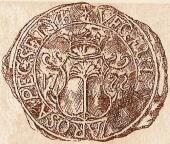
The seal of the city is round with the town coat of arms in the middle and with the annular title The City of Fiľakovo. The seal is used on important ceremonies.
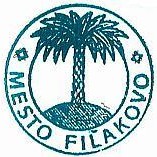
Another seal from the end of the 18th century is red. The golden crown is on the top of the hill. A double-armed silver cross is growing from the crown. There is a green palm behind it. It was used during the reign of Leopold II (1790 - 1792). Nowadays the town uses the simplier version of the coat of arms from the year 1772, that is a palm growing from a green hill with a yellow trunk and a green crown.

The city flag consists of six longitudinal stripes of the following colours: yellow, green, white, yellow, green, white. Its ratio is 2:3 and it is ended in a so called swallow tail.

History of town and castle
The names during the period
1246 Filek, 1262 Fylek, 1348 Castrum Phylek, 1385 Oppidum Fylek, 1528 Filekwar. Other names: Vilk, Villagkk, Vieleck, Filekinum, 1684 Villeck, 1685 Filleck, 1742 Filek, 1786 Fülek, Filakowo, 1863-1913 Filekow, 1920 Filakovo, 1938-1945 Fülek, 1948-1990 Fiľakovo, since 1991 Fiľakovo (in Slovak) and Fülek (in Hungarian).
History
In the 12-th century there was already the castle with a square tower, palace and palisade on the volcanic top of a basalt rock 65m high.
The origin of the castle is connected with the tale about a shepherd called Filek, and his dog Fules, as they found treasure, from which a castle was built.
The first written record comes from the year 1242, where it is written, that the castle survived the Tartar incursion.
Another record says, that a robber knight called Fulko was the owner of the castle as long as king Belo IV confiscated it in 1246. Then the castle was owned by several owners: knight Hartwig (1283), Master Egyed, Matúš Csák (1311-1321), Blažej Fónyi (1322.) In the years 1348 and 1385 it is mentioned as a royal property. In the year 1435 the castle was given as a mortgage to the Perényi family.
In the year 1440 queen Elizabeth, the owner of the castle, accredited Ján Jiskra to ensure the domain. In the year 1483 the castle was conquered by Matej Korvín who expelled Štefan Perényi from the castle.
From the year 1490 captain Raškaj is authorized to administer the castle. His daughter married František Bebek and the castle was given to him as a marriage portion.
As the Turkish danger rose, the castle was rebuilt in 1551 according to the plans of an Italian architect Alessandro Da Vedano into a massive renaissance fortress. It was enlarged and stronged. The middle and lower castle was built with two pentagonal bastions, walls, entrance corridor and cannon positions. In the same time the town got the wall with the gates and bastions as well.
The castle was a component of the defence line against the Turkish expansion in the 16-th century. In 1554 the Turks captured the castle and had been governing in and around Filakovo for 39 years.
The territorial integrity of Novohrad has been violated by the Turks in the second half of the 16th century. They were successful in subduing almost the whole territory of the county (they conquered also the castles of Novohrad, Modrý Kamen, Divín, Šomoška, Salgó ant others). From Filakovo beg Hamza and after him other begs (Velidžan (1562-1564), Arslan beg (1564), Mehemed (Mahmat 1575), Hasan (1576), Mahmud (1579), Korkud (1579-1590), Ali (1591) a Jusuf beg (1593)) ruled to the large part of southern Slovakia, called Filakovo sanjak.
Counts Nicholas Pállfy and Christooph Tiefenbach with the royal army liberated the castle and its surroundings in 1593. There was a fire, which ruined a part of the castle and town in 1615. Stephanus Koháry I got the castle from the emperor in 1657. His son, Stephanus Koháry II ordered to rebuild the ruined parts in 1667.
Emerich Thököly, the reigning prince of Transsylvania with the help of the big Turkish army captured the castle in 1682. The castle was destroyed and since this year remained in ruins. Thököly was proclaimed the Hungarian king here. Stephanus Koháry II after his liberation from Thököly's confinement ordered to build the new church and monastery in 1725.
The last owners of the castle were the Coburgs.
From the year 1972 conservation of the castle ruins is realised. The castle is opened for public since 1993.
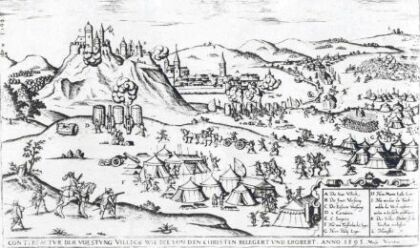
- Hernády Károly, Nógradi várak, Panoráma 1982
- J. Halaj a kol., Novohrad, Regionálna vlastivedná monografia, 1.diel: Príroda, Osveta, Martin 1985
- Novohrad, Regionálna vlastivedná monografia, 2.diel: Historia
- Krásy Slovenska 1-2 1995, str. 26
- Jozef Drenko, Fiľakovský hrad, monografia
- Jozef Drenko a kolektív, Fiľakovo, monografia pri 750. výroči 1. písomnej zmienky o meste, MSU Fiľakovo 1996
- P. König Kelemen, Fülek vára, OFM 1942
Informations for visitors
 Contacts
Contacts
Hlavná Street 14, 986 01 Fiľakovo, Slovakia
tel.: 00421(0)47/4382017, 00421(0)47/4382619
email: This email address is being protected from spambots. You need JavaScript enabled to view it.
web: www.hradfilakovo.sk
Opening hours
- 15th march - 31st október: Monday - Sunday: 10:00 - 18:00
- 1st november - 15th november: Monday - Sunday: 8:00 - 16:00
Entrance into the castle is from Podhradska street. Parking (either by car and bus) is possible on a new parking place nearby the castle entrance gate. We recommend you to visit The Town Museum in the town centre.
Entrance fee and service
Enter fee into the Castle area within the exposition and the bomb shelter
- visitors under 6 years and above 70 years: 0 €
- visitors between 7 years and 26, 62 and 69 years: 2.00 €
- visitors between 27 years and 61 years: 4 €
Tourist Guide
- tourist guide service: 5 € / group
The Card of Friends of Fiľakovo Castle
- seniors - above 26 years: 5 €
- juniors - till 26 years: 2.00 €
Commercial photography and recordings
- a photographer or a cameraman + two persons: 12 €
- a photographer or a cameraman + more persons: 20 €
- short-range hire of the castle yard for commercial use (18x25=450m2) (100% discount for traditional events organized by the town): 200 €
- non-resident sales on events in the castle area (100% discount for craftsmen selling their own products on events organized by the town): 10 €/day/1 sq.m
Entrance fee to the exposition "Fiľakovo 1938-1945" in the bomb shelter under the castle hill
- visitors under 6 years and above 70 years: 0 €
- visitors between 7 years and 26, 62 and 69 years: 1.00 €
- visitors between 27 years and 61 years: 2 €
The Castle Museum in Fiľakovo
Franciscan Father K. König was the first who came with idea to establish the castle museum in 1941. He established the first Castle Commitee as well. The Commitee began to gather money to set up the institution and an entreaty was sent to the Hungarian National Museum in Budapest to make an archeological research of the area. The research started in 1944 under the conductorship of dr. János Kalmár. The world war stopped the process of establishing the museum and the research itself too.
The first regional museum of the „Slovak part“ of Novohrad region was established in 1951. It was called The County Museum of National History and Geography in Fiľakovo. In 1960 it was transformated into the City Museum. The County Museum of National History and Geography in Lučenec moved to Fiľakovo in 1967. It´s seat was in Halič castle from the year 1955. From 1967 to 1984 there were two constant expositions: the exposition of the Town Museum - on the ground floor of the Franciscan monastery and the exposition of the Novohrad Museum - in Vigado. In 1984 the Novohrad Museum moved to Lučenec because of the bad conditions and in 1988 the exposition in the monastery was closed down too.
In 1993 a new era in the history of Fiľakovo museum has begun. The Ministry of Culture of the Slovak Republic accepted the requests of the town. Part of the collection was donated to the town Fiľakovo. The reconstructed Town Museum became the department of the Town Cultural Centre and a constant exposition was opened in 1994 in three rooms of Vigado. After 15 years there was a need to reorganize the institution.
Another idea of establishing the Castle Museum came again in 2005. Between 2006 - 2007 there was a reconstruction of the interior of the Bebek Bastion and it´s adaptation into the museum. In April 2007 the Castle Museum in Fiľakovo was established. In August 2008 a constant exposition called The Centuries of Fiľakovo castle was opened in the museum. Visitors can learn about the history of the town and the castle from the first written reference to 1682 when the castle was destroyed. There are exhibited valuable medieval finds and finds from the Slovak National Museum, the original castle keys and things from the Turkish occupation. On the ground floor there are valuable finds from the most important archeological localities.
The Town Museum of National History and Geography works in a new institution. It´s exposition was closed in summer 2008. The building is going to be reconstructed and the new exposition will be about the history of Fiľakovo after the destruction of the castle. The Castle Museum organizes short exhibitions in the so called Gallery of the Town Museum and on the other two floors of the Bebek Bastion.
The Novohrad Tourist and Information Centre
![]() The Novohrad Tourist and Information Centre is an information office working under the auspices of the city of Fiľakovo. Its main aim is to gather information and to inform the local citizens and the tourists as well. Its field of workings is the southern part of the Banská Bystrica region and the northern part of Nógrád county in Hungary. It also provides information about attractive tourist destinations within the Slovak republic.
The Novohrad Tourist and Information Centre is an information office working under the auspices of the city of Fiľakovo. Its main aim is to gather information and to inform the local citizens and the tourists as well. Its field of workings is the southern part of the Banská Bystrica region and the northern part of Nógrád county in Hungary. It also provides information about attractive tourist destinations within the Slovak republic.
It functions according to the trade license for the following activities:
- Sale of promotionals materials
- Promotional and marketing services
- Organization of sport, cultural and other events
- Administrative services
It provides useful information:
- about cultural monuments, protected areas, national parks, geological fields and monuments, caves, water tourism (lakes, pools, spas), about how far are these areas and how much is the enter fee,
- about tourist pathways and cycling routes in the Geopark area,
- about the institutions in the city and its surroundings,
- about the cultural events within the IC,
- about administrative services according to the list of prices and charges,
- about free promotional leaflets,
and services:
- making and distributing of posters and promotional materials.
The NTIC cooperates with the Tourist information centre in Rimavská Sobota, the City informations centre in Lučenec, the Tourist agency TOURINFORM in Salgótarján and with other partner cities such as Bátonyterenye and Szécsény. All kinds of cooperations are contracted. The NTIC also cooperates with other organizations in the field of culture and development such as the Banská Bystrica self-governing region, the Department of culture and tourism, the Slovak Environmental Agency, the Slovak Union of Tourists, the Administration of Cerova upland Protected Area, the Neogradiensis Region with its self-governing villages within the Novohrad Geopark. They offer possibilities of promoting information about local activities and events.
Open hours
Monday-Friday
8:00 a.m. - 4:00 p.m.
Contact
Podhradská u. 1985/14,
98601 Fiľakovo
tel./fax.:+421 (0)47 4382016
tel.: +421 918 994 481
email: This email address is being protected from spambots. You need JavaScript enabled to view it.
position on map
National Cultural Monuments
The Filakovo Castle
In the 12th century there was already the castle with a square tower, palace and palisade on the volcanic top of a basalt rock 65m high. In 1551 it was enlarged and stronged. The middle and lower castle was built with two pentagonal bastions, walls, entrance corridor and cannon positions. In the same time the town got the wall with the gates and bastions as well.
The origin of the castle is connected with the tale about a shepherd called Filek, and his dog Fules, as they found treasure, from which a castle was built.
The old records says, that a robber knight called Fulko was the owner of the castle as long as king Belo IV confiscated it in 1246. Then Matus Csák (1311-1321), queen Elizabeth (1438) and Francis Bebek were the owners of the castle.
The castle was a component of the defence line against the Turkish expansion in the 16-th century. In 1554 the Turks captured the castle and had been governing in and around Filakovo for 39 years. Counts Nicholas Pállfy and Christooph Tiefenbach liberated the castle and its surroundings in 1593. There was a fire, which ruined a part of the castle and town in 1615. Stephanus Koháry I got the castle from the emperor in 1657. His son, Stephanus Koháry II ordered to rebuild the ruined parts in 1667.
Emerich Thököly, the reigning prince of Transsylvania with the help of the big Turkish army captured the castle in 1682. The castle was destroyed and since this year remained in ruins. Thököly was proclaimed the Hungarian king here.
Stephanus Koháry II after his liberation from Thököly's confinement ordered to build the new church and monastery in 1725. The last owners of the castle were the Coburgs.
The Church Devoted to Holy Mary´s Assumption and the Franciscan Monastery
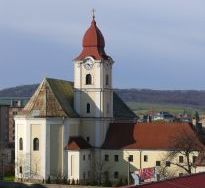 The Roman-Catholic Church
The Roman-Catholic Church
The original church with the Franciscian Monastery from 1513 was changed to Turkish temple in 1554 - 1593. In 1682 it was destroyed. The church was rebuilt in 1694 - 1727 by István Koháry II. Its present form is from 1728. The baroque interior of the church is richly decorated. The tower is situated uncharacteristically on its north-eastern side.
The Franciscian Monastery
The monastery is connected with the north-western side of the church. The building has two floors. Franciscan friars had significantly influenced the spiritual life of the town.
Immovable Monuments
The Berchtold Castle
The Berchtold castle is a marvellous baroque building, which was built in 1826 and reconstructed in the late baroque style in 1830. It was originally built by Berchtold Antal and later it belonged to the Herold and Stephani families. Nowadays it is the building of the Gymnasium (secondary school). A favourite place for relaxation is a park of seven hectares behind the castle.
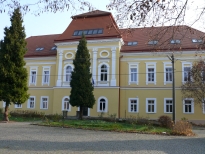
The Cebrian Castle
Along with baroque we can also find classic architecture in Fiľakovo: the Cebrian Castle. The Cebrians were of Spanish origin and acquired an estate in Fiľakovo at the beginning of the 19th century.
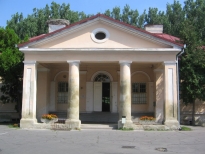
Koháry's kuria-house
After 1682, when the castle was destroyed, Istvan Kohary II built a baroque kuria-house (mansion) for himself. The building was built on basics of older Báthory kuria from the 17th century.
Later, in the 19th century the Coburg family was the owner of the mansion. After World War I the local residents became the owners. At present time the building is unutilized.

The City Hall
One of the most famous buildings in the town is the Town Hall. Schmidt Pál, a master builder from Lučenec began to build it in April 1911 according to the plans of Jakab Pál. It was opened on 29 June 1912. Originally it was a residence of the local fire department. A feature of the building is the fire watchtower, from which the whole town can be seen.

The Vigado
The eclectic building of the Vigado was built at the beginning of the 20th century and is still a vitalpart of Fiľakovo's cultural life. It has been used as a casino, meeting place for organizations, inn, restaurant, hotel, school, museum and library. Today it houses the Town Cultural Centre and the Town Museum.
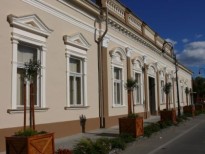
The City Park
It arose from the original Turkish gardens. It was established in the second half of the 19th century near the castle of the Berchtold family. There can be found not only local plants, but also exotic trees. There is also situated a small lake.

The Square of Fallen Heroes
It is situated in front of the Berchtold castle. It was part of the park in the second half of the 19th century. Nowadays there is a monument of World War I, a monument of fallen heroes of the Soviet army from World War II and a memory column of the 1848-1849 revolution heroes.
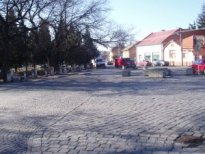
The Mausoleum of the Stephani family
It is situated on a hill of a small cemetery.
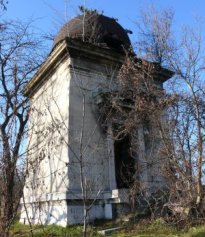
The Statue of Holy Ann
It was built in 1907.
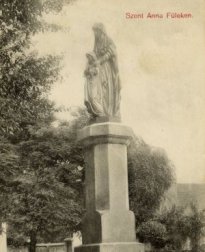
The Statue of Holy Urban
It was built in 1796. It was rebuilt on the 25th May 1920 and later in 1997.
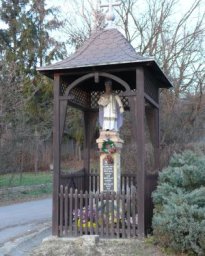
The Jewish cemetery
In 1820 the Jews living in Fiľakovo got a permission to have their own Jewish cemetery near Šávoľ road.
